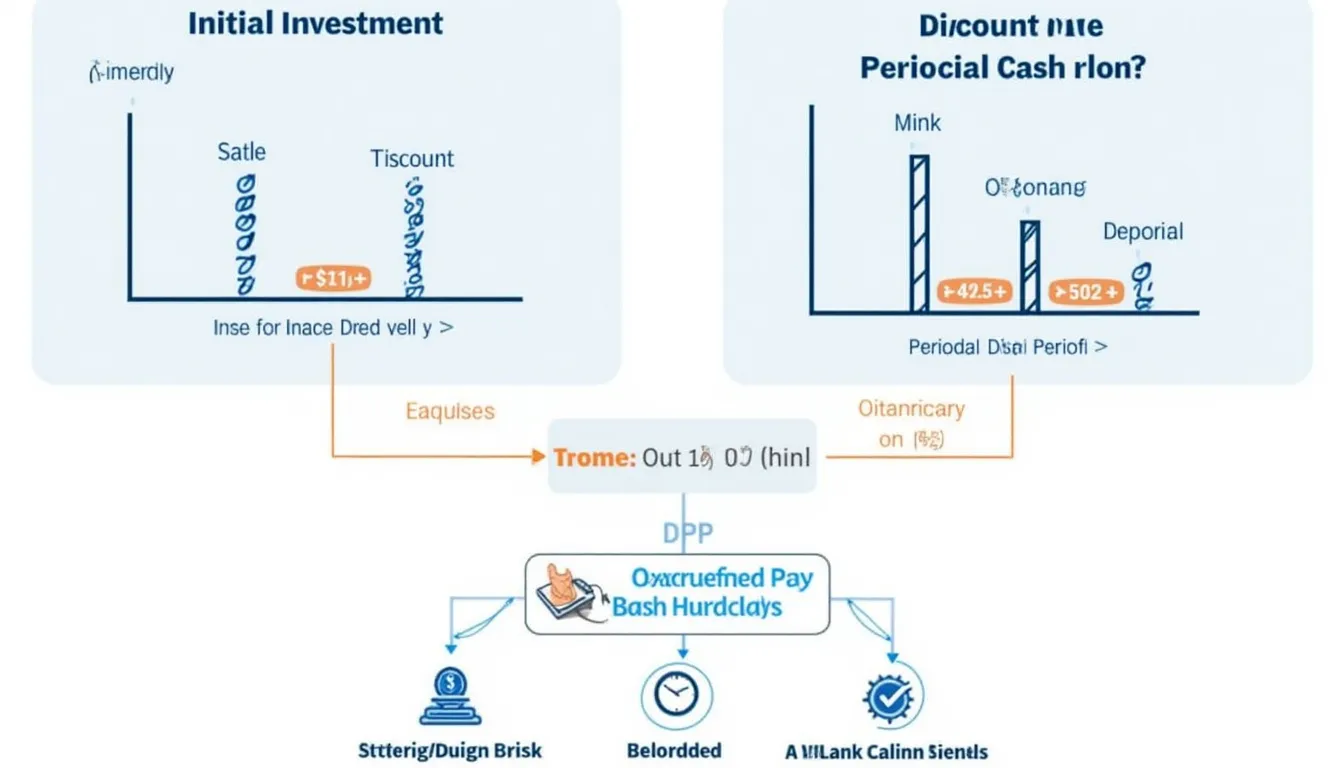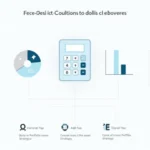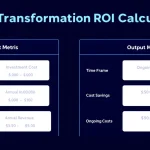Discounted Payback Period Calculator
Is this tool helpful?
How to Use the Discounted Payback Period Calculator Effectively
Unlock the full potential of the Discounted Payback Period Calculator by following these clear, easy-to-use steps. This ensures accurate and meaningful results that help you evaluate investment profitability with confidence.
- Enter the Initial Investment ($): Provide the total upfront cost of your investment. For example, input 75000 or 150000. This represents the capital outlay needed at the start.
- Specify the Discount Rate (%): Enter the discount rate reflecting the time value of money and investment risk. Try values like 7.5 or 12. The rate quantifies how future cash flows are adjusted to their present value.
- Input the Periodic Cash Flow ($): Fill in the expected recurring cash inflow generated by the investment, such as 12000 yearly or 8500 quarterly. This value should represent consistent, periodic returns.
- Click “Calculate”: Submit the data to quickly compute the Discounted Payback Period, revealing how many years it will take to recover your investment accounting for discounted cash flows.
- Interpret the Result: View the result displayed in years, helping you assess payback speed while incorporating time value of money principles for deeper investment insight.
By accurately entering realistic figures and understanding each input’s role, you can efficiently estimate your investment’s discounted payback period and make more informed financial decisions.
What is the Discounted Payback Period? Definition, Purpose, and Key Benefits
The Discounted Payback Period (DPP) is an essential financial metric used to determine the time required for an investment to repay its initial cost, while factoring in the time value of money. Unlike the traditional payback period, which simply aggregates cash flows, the DPP discounts those cash flows to present value, offering a more accurate reflection of investment recovery.
This calculation helps investors and business professionals understand not only how quickly their investment will break even but also the impact of risk and opportunity cost inherent in delayed returns.
Mathematically, the Discounted Payback Period is defined by the formula:
$$DPP = \frac{\ln\left(\frac{1}{1 – \frac{I \times r}{C}}\right)}{\ln(1+r)}$$
- I: Initial Investment
- r: Discount Rate (expressed as a decimal)
- C: Periodic Cash Flow
Main Benefits of Using the Discounted Payback Period
- Accurate Investment Appraisal: Considers the time value of money for a realistic recovery timeline.
- Better Risk Evaluation: Helps identify investments with longer, riskier recovery periods.
- Informed Capital Allocation: Enables smarter decisions comparing diverse investment opportunities.
- Supports Long-Term Planning: Aligns investment evaluation with strategic financial goals.
- Enhanced Financial Insight: Offers a nuanced perspective beyond simple payback metrics.
Example Calculation Using the Discounted Payback Period Calculator
To illustrate the calculator’s practical application, consider this example:
- Initial Investment: $120,000
- Discount Rate: 8%
- Periodic Cash Flow: $30,000 annually
Using these inputs, the calculator determines the time (in years) it will take for the investment’s discounted cash flows to cover the initial $120,000 expense.
The resulting Discounted Payback Period offers an insightful timeline that reveals if the investment recoups costs quickly or involves a longer financial commitment. This empowers you to evaluate if the investment fits your risk tolerance and financial strategy.
Key Advantages of the Discounted Payback Period Calculator in Investment Analysis
Time Efficiency and Ease of Use
Our online calculator eliminates manual computations, delivering rapid results with minimal effort, perfect for professionals who need quick yet reliable investment insights.
Precision and Reliability
Employing exact mathematical formulas ensures calculations are accurate, reducing errors common in spreadsheet or manual analysis.
Versatility for Different Investment Scenarios
Easily adjust inputs to analyze various projects, enabling side-by-side comparisons and better scenario planning.
Enhanced Decision-Making Support
By shining light on payback timing with discounted cash flows, the calculator aids in prioritizing investments with favorable returns and aligning choices with financial goals.
Educational Value for Financial Learning
Ideal for finance students and professionals exploring time value of money concepts, this tool visually demonstrates the impact of discounting on investment timelines.
Practical Applications and Real-World Use Cases
The Discounted Payback Period Calculator is widely useful in various industries and financial contexts, including but not limited to:
1. Capital Equipment Investments
Companies investing in costly machinery can use this calculator to determine the time frame for recovering expenditures while accounting for operational risks and cost of capital.
2. Real Estate Project Evaluations
Real estate developers assess the financial feasibility of properties and rental income streams over time, making discounting a crucial factor in decision-making.
3. Renewable Energy Investments
Evaluating solar or wind projects with uncertain cash flows and varying discount rates benefits from discounted payback period analysis to determine financial viability.
4. Marketing and Business Growth Initiatives
Businesses investing in marketing campaigns or new product launches can quantify how long it takes to recover those costs while considering return timing.
5. IT and Infrastructure Upgrades
Departments evaluating technology investments can justify spend by computing discounted payback periods, reinforcing budget approval processes.
Frequently Asked Questions About the Discounted Payback Period and Calculator
What differentiates the Payback Period from the Discounted Payback Period?
The traditional payback period counts time to recoup investment ignoring time value of money, while the discounted payback period incorporates discounting future cash flows, offering a more precise timeline.
How does changing the discount rate influence the Discounted Payback Period?
Higher discount rates increase the DPP by lowering the present value of future cash flows, causing a longer expected recovery time.
Can the Discounted Payback Period ever be negative?
No, since it measures the time needed to recover an investment, it logically cannot be less than zero.
Is this calculator suitable for personal finance evaluations?
Absolutely. Individuals can utilize this tool to assess investments such as rental properties or business ventures, factoring in the value of money over time.
Are there limitations to relying solely on the Discounted Payback Period?
Yes, this metric excludes cash flows beyond the payback horizon and overall profitability. It should be supplemented with other analysis tools like Net Present Value (NPV) or Internal Rate of Return (IRR) for comprehensive investment assessment.
Note: While our Discounted Payback Period Calculator strives for accuracy, all inputs and assumptions should be carefully reviewed. For significant financial decisions, consult with a qualified financial advisor to complement tool-based insights.
Conclusion: Empowering Smarter Investment Decisions
Incorporating the Discounted Payback Period into your investment analysis toolkit enhances your ability to evaluate payback timing with precision, accommodating the critical influence of time value and risk.
Our user-friendly calculator delivers quick, accurate results that support:
- Efficient financial analysis saving you time and effort
- Improved accuracy in assessing investment recovery times
- Better understanding of risk profiles through discounted cash flow evaluation
- Scenario comparisons for more strategic decision-making
- Alignment with long-term financial goals enhancing portfolio management
Whether you are a seasoned investor, business professional, or student of finance, leveraging the Discounted Payback Period Calculator will elevate your investment evaluations and empower you to make smarter, data-driven choices.
Start using the calculator today to gain deeper insight into your investments and confidently navigate your financial journey!
Important Disclaimer
The calculations, results, and content provided by our tools are not guaranteed to be accurate, complete, or reliable. Users are responsible for verifying and interpreting the results. Our content and tools may contain errors, biases, or inconsistencies. Do not enter personal data, sensitive information, or personally identifiable information in our web forms or tools. Such data entry violates our terms of service and may result in unauthorized disclosure to third parties. We reserve the right to save inputs and outputs from our tools for the purposes of error debugging, bias identification, and performance improvement. External companies providing AI models used in our tools may also save and process data in accordance with their own policies. By using our tools, you consent to this data collection and processing. We reserve the right to limit the usage of our tools based on current usability factors.







